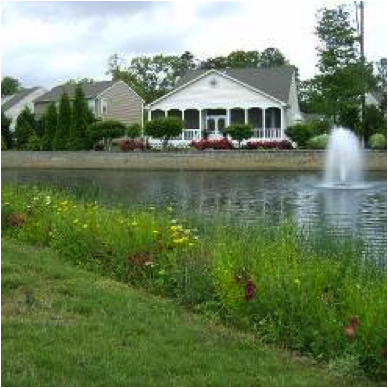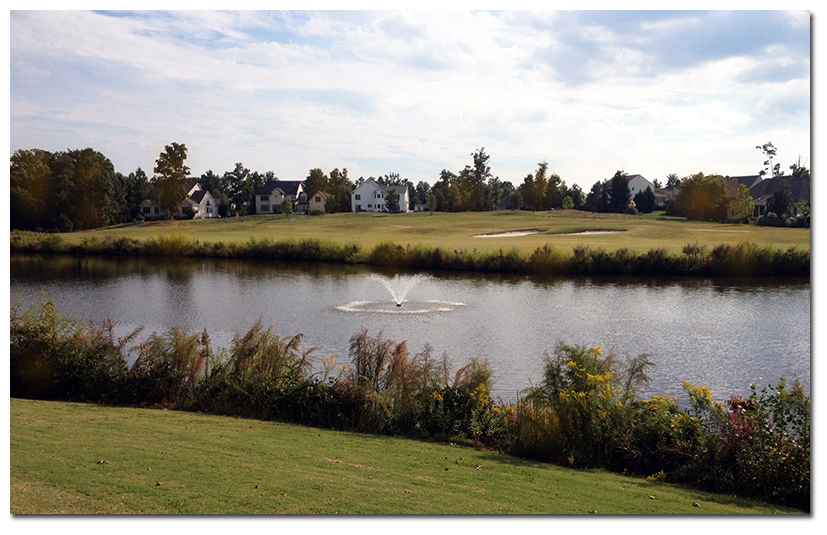In the Buff: Vegetation Management
July 26th, 2009
By Industry Expert David Ellison, Aquatic Biologist
 Shoreline vegetative buffer zones are important areas along the perimeter of your pond that will provide multiple benefits. Certain plants are chosen and plants needing moisture are placed at the shore to upland dry plants along the land side edge of the buffer. Reducing nutrient runoff entering the pond, stabilizing the pond back, and providing shelter for many animals are some of the benefits of having a buffer zone. Establishing a vegetation management plan is important for the overall health of your pond.
Shoreline vegetative buffer zones are important areas along the perimeter of your pond that will provide multiple benefits. Certain plants are chosen and plants needing moisture are placed at the shore to upland dry plants along the land side edge of the buffer. Reducing nutrient runoff entering the pond, stabilizing the pond back, and providing shelter for many animals are some of the benefits of having a buffer zone. Establishing a vegetation management plan is important for the overall health of your pond.
Buffer zones can reduce pond algae blooms by preventing excessive amounts of nitrogen and phosphorous entering the pond. As water enters the pond the plants assimilate nitrogen and phosphorous and utilize these nutrients for growth. This is vital to overall pond health as excessive amounts of these nutrients often cause algae blooms and lead to poor water quality.
Erosion along pond banks can also decrease water quality when dirt from erosion enters the pond and adds extra nutrients to the pond and creates a turbid aquatic environment. A well maintained buffer will stabilize the substrate and prevent loss of the pond bank. The width of the buffer can vary, but should be more than a couple of feet to allow for multiple plants to protect the pond. Protection from predation is also available for many animals within the buffer zone.
In ponds with extremely shallow banks some aquatic plants will also provide the same benefit as plants along the aquatic-land interface. Pickerelweed is one such plant that takes up excessive nutrients, provides protection for pond fish and ducks, and is aesthetically pleasing with the purple flowers it produces. Some of the desirable plants in a buffer zone from aquatic to upland plants are pickerelweed, rushes (soft, blue), Japanese silver grass, dwarf fountain grass, and other shrubs at the landward edge of the buffer.
 Buffer zones should consist of moisture loving plants along the pond to plants requiring little saturation periods as you near the edge of the buffer. Trees should not be planted in buffer zones as their roots will often eliminate the plants that will be more beneficial in nutrient uptake than trees. Trees already in a buffer zone can remain to help stabilize banks, but should be trimmed so they do not take over the buffer. Also, fewer pesticides are often needed in ponds with well established buffers. Establishment of a buffer zone will provide long term benefits for your overall annual pond management plan.
Buffer zones should consist of moisture loving plants along the pond to plants requiring little saturation periods as you near the edge of the buffer. Trees should not be planted in buffer zones as their roots will often eliminate the plants that will be more beneficial in nutrient uptake than trees. Trees already in a buffer zone can remain to help stabilize banks, but should be trimmed so they do not take over the buffer. Also, fewer pesticides are often needed in ponds with well established buffers. Establishment of a buffer zone will provide long term benefits for your overall annual pond management plan.
David Ellison is an Aquatic Biologist with SOLitude Lake Management.Since 1998, SOLitude Lake Management has been committed to providing full service lake and pond management services that improve water quality, preserve natural resources, and reduce our environmental footprint. Services are available throughout the Eastern United States. Fisheries management consulting and aquatic products are available nationwide. Learn more about SOLitude Lake Management and purchase products at www.solitudelakemanagement.com.
Download Free Report Contact the experts at 888-480-5253 for all of your lake, pond and fisheries management needs.










